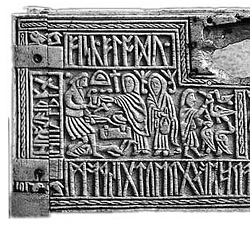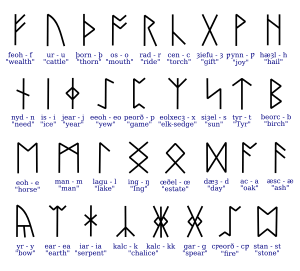Futhorc facts for kids

The Anglo-Saxon alphabet is a special kind of writing system called a runic script. People used it a long time ago, from the 5th to the 8th century. It was an improved version of an older runic alphabet called Elder Futhark.
The Elder Futhark had 24 letters, but the Anglo-Saxon alphabet had more, usually between 26 and 33. Just like the Elder Futhark, this new alphabet got its name from its first few letters. When we write these letters in modern English, they spell Futhorc.
People used Futhorc to write down two old languages: Old English and Old Frisian. Old English was the language spoken in England before modern English developed. Old Frisian was a language spoken in parts of what is now the Netherlands and Germany.
After the 9th century, it became rare to find things written with Futhorc. By the time of the Norman Conquest in 1066, this writing system had completely disappeared. The Norman Conquest was when William the Conqueror from Normandy (a region in France) took over England.
What is Futhorc?
Futhorc is a unique alphabet that looks very different from the letters we use today. Each symbol, or rune, often had a name that was a common word. For example, one rune might be named after a tree, and another after a person. This helped people remember the runes.
Historians and language experts study Futhorc to learn more about the Anglo-Saxon people. They look at old objects like knives, jewelry, and stones that have these runes carved into them. These carvings can tell us about their beliefs, their history, and even who made the objects.
How Futhorc Was Used
Futhorc was mainly used for short inscriptions. You might find it on important items like weapons, tools, or even small pieces of jewelry. Sometimes, it was used on stone monuments. These inscriptions often named the owner, the maker, or had a short message.
It was not usually used for long books or documents. For longer writings, people in Anglo-Saxon England started using the Latin alphabet, which is similar to the one we use today. This was because of the spread of Christianity, which brought Latin writing with it.
Why Did Futhorc Disappear?
There are a few reasons why Futhorc stopped being used. One big reason was the growing influence of the Latin alphabet. As more people learned Latin for religious and scholarly purposes, the Latin alphabet became more common. It was also easier to write with a pen on parchment (an old type of paper) than to carve runes.
Another reason was the Norman Conquest. After the Normans took over England, they brought their own language (Old French) and writing customs. This further pushed out the use of Old English and, along with it, the Futhorc alphabet.
Images for kids
-
Futhorc series on the Seax of Beagnoth (9th century). The series has 28 runes, omitting io. The shapes of j, s, d, œ and y deviate from the standard forms shown above; eo appears mirrored.
See also
 In Spanish: Futhorc para niños
In Spanish: Futhorc para niños





